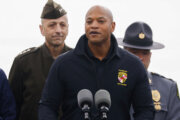SHARON COHEN
AP National Writer
The National Guard is a regular presence in responding to natural disasters, but it also has a long history in helping curb civil disturbances.
On Monday, Missouri Gov. Jay Nixon mobilized the Guard to the town of Ferguson, where protests stemming from the shooting of an unarmed 18-year-old resident are now in their second week. The governor said he acted to protect the people and property from a “violent criminal element intent upon terrorizing the community.”
Here are some questions about the Guard, its activities and its role in Ferguson:
Q: What is the National Guard?
A: The National Guard is a reserve military force that can be mobilized under state or federal authority. About 470,000 people are currently members of the Army or Air National Guard; most have civilian jobs and serve part time in the Guard. There are Guard units in every state as well as the District of Columbia and the territories of Guam, the Virgin Islands and Puerto Rico. The Guard is in more than 3,200 communities. About 11,000 Guard members are in Missouri.
Q: Why is the Guard in Ferguson?
A: Nixon deployed the Guard early Monday to “restore peace and order” to the St. Louis suburb following another night of violent clashes between police and protesters that involved Molotov cocktails thrown at officers, looting, vandalism and gunfire. Police responded with tear gas. The demonstrations have been sparked by the Aug. 9 fatal shooting of 18-year-old Michael Brown by a white police officer. Brown was black.
The governor said in a statement that he deployed the Guard because of “coordinated attacks last night both on civilians and law enforcement officers.” Nixon said the Guard’s involvement will be a “limited mission.” President Barack Obama said he told Nixon he’ll be watching to determine if the Guard’s presence is beneficial or harmful. Nixon on Monday lifted a midnight-5 a.m. curfew that he had imposed two days earlier.
Q: Who’s in charge?
A: The Guard will be under the direction of Col. Ron Replogle of the Missouri State Highway Patrol. Missouri National Guard Brig. Gen. Gregory Mason will oversee Guard operations. It’s the standard way of operating when the Guard is called to help quell civil disturbances. “We’re always in support, never in the lead domestically. We take orders from the lead law enforcement agency on the scene,” said Rick Breitenfeldt, a spokesman at the Guard’s national headquarters.
Q: Who can deploy the Guard?
A: Governors or the president can deploy the Guard. In at least 10 cases since World War II, the president has mobilized the Guard for wide-ranging missions, invoking the Insurrection Act. Among them: the 1957-58 desegregation of Central High School in Little Rock, Arkansas; the 1965 Selma to Montgomery, Alabama, civil rights march; the 1967 riots in Detroit; the 1968 riots in numerous cities following the assassination of the Rev. Martin Luther King Jr.; the 1970 New York City postal strike; and the 1992 Los Angeles riots after four police officers were acquitted in the beating of Rodney King. In that last case, the Guard was originally mobilized by the state. After two days, then-President George H.W. Bush called the Guard into federal service.
Q: What other activities has the Guard been involved in?
A: Guard members have been mobilized in the wars in Iraq and Afghanistan, peacekeeping duty in the Balkans and the Sinai and numerous natural disasters. In the wake of Hurricane Katrina in 2005, the Guard dispatched more than 50,000 troops to help the Gulf states.
In Texas, Gov. Rick Perry recently announced the deployment of Guard troops to the Texas-Mexico border, where there has been a surge in illegal immigration this summer — most notably unaccompanied children from gang-ravaged Central American nations. In coming weeks, up to 1,000 additional Guard troops are expected to arrive at the border to beef up the Texas Department of Public Safety’s “Operation Strong Safety.” The soldiers will largely serve as surveillance in what officials have called a “deter and refer” mission.
During fiscal year 2013, the Guard said, it responded to 28 wildfires, 14 floods, 10 winter storms, three hurricanes, a tornado and a tropical storm.
Copyright 2014 The Associated Press. All rights reserved. This material may not be published, broadcast, rewritten or redistributed.







